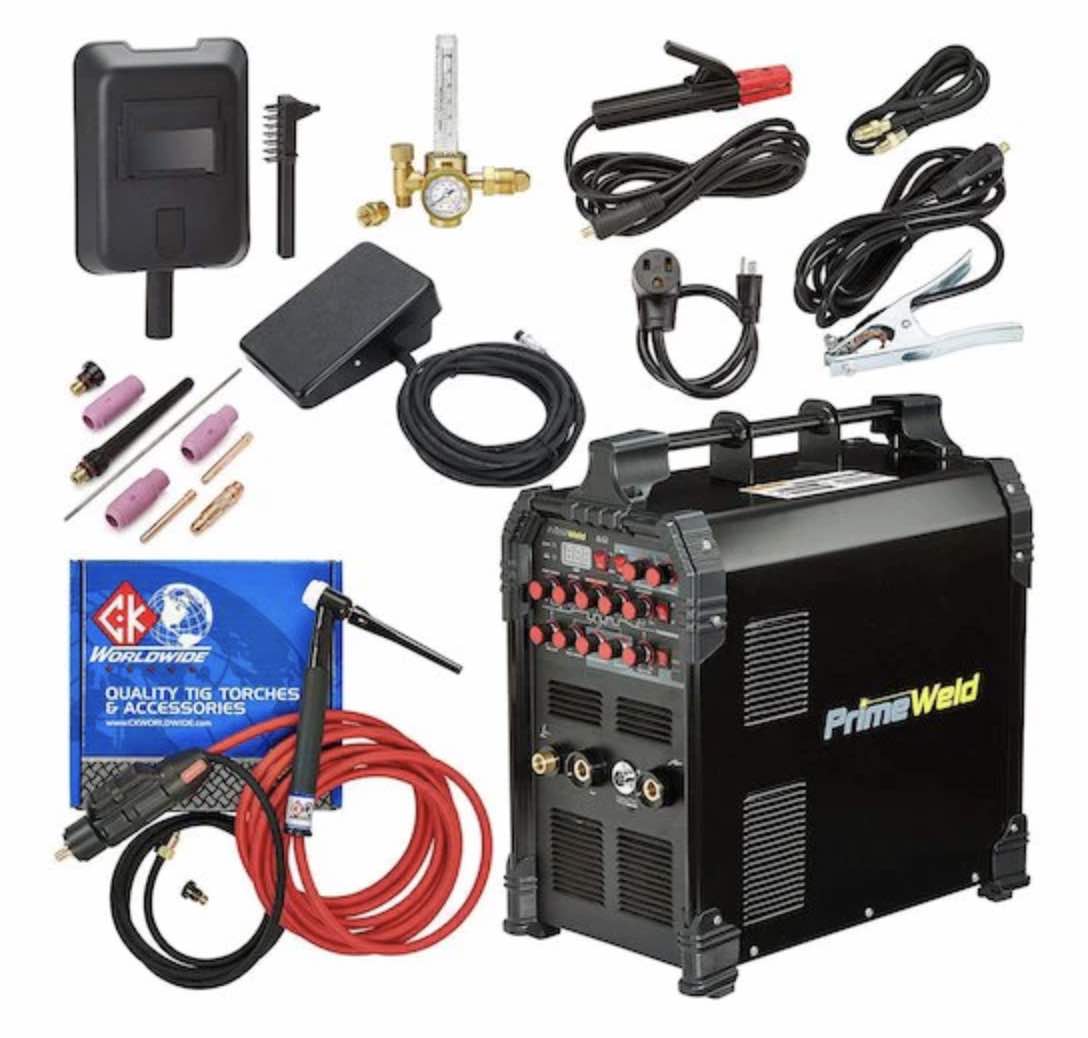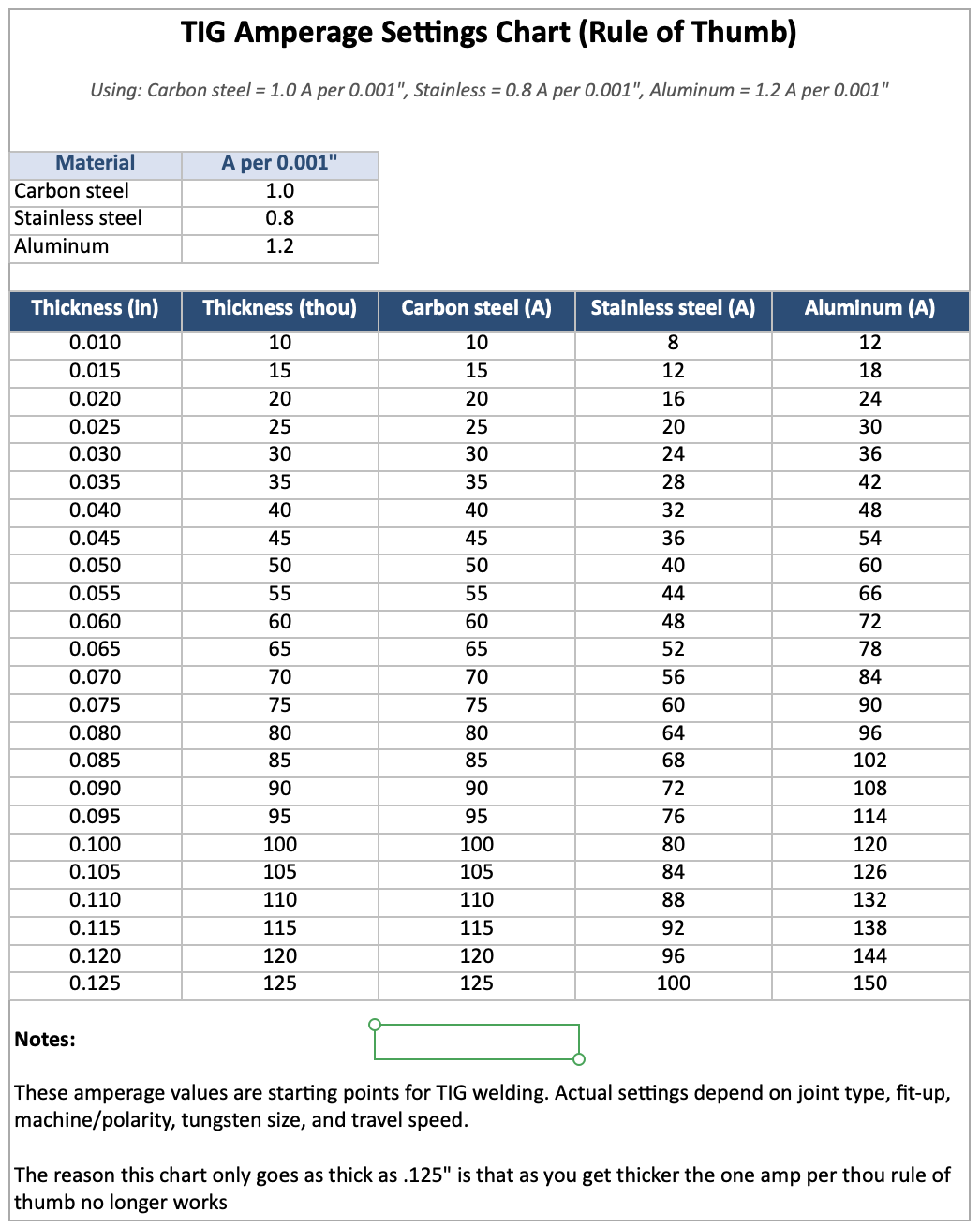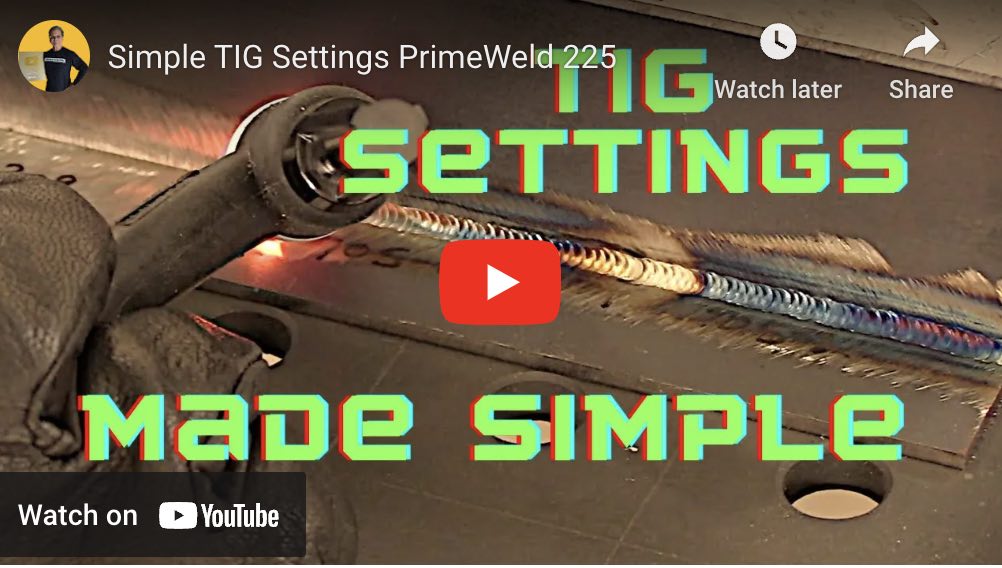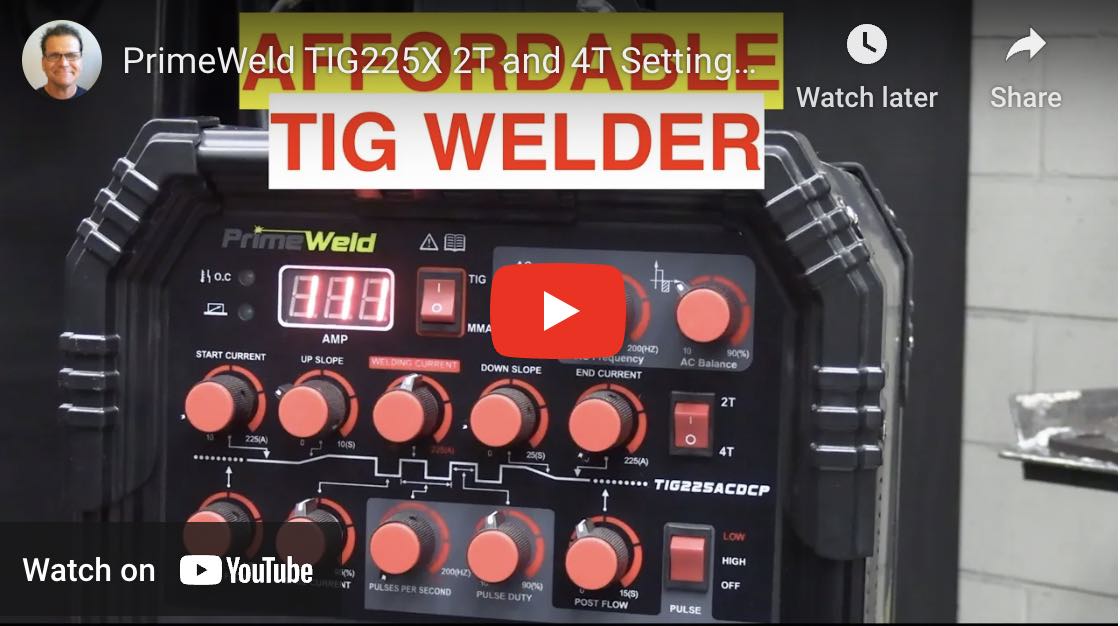Tig Welder Settings Made Simpler...one stop shop
Learn more about this affordable tig welder with bonus kit at weldmonger.com
see more tig settings chart info here
In my opinion, the primeweld 225 is one of the best choices in affordable tig welders.
The problem with most other really affordable tig welders is usually the foot pedal and the torch are just bad and clunky.
Primeweld went to extra expense to include genuine ck torches with superflex hoses along with a smooth SSC style foot pedal.
They also have a responsive primeweld equipment users group on facebook and also have demonstrated great customer support
Watch some primeweld videos and you will see what I mean.
TIG Welder inverters have a bunch of settings and if you don’t understand what they do, you will never get the most out of your inverter tig welding machine.
With inverter technology, you can have a 300 amp machine that can easily be carried by one person or wheeled around the shop on a light duty cart.
And the really great thing about tig inverters is that the arc can be tweaked to your liking much more so than with conventional transformer tig welders.
But only if you understand what all those freakin knobs are for.
So let’s talk about the main tig welding inverter settings. Some of the settings that you need to really get a handle on are:

See Hundreds of Quick 30 second videos showing TIG welder settings for all types of Welds
• Amperage—pretty straightforward...but there is a simple rule of thumb that holds true up to about .125" thick metal. (3.2mm)...mainly for carbon steel
one amp per one thousandths (thats about 40 amps per 1 mm)
A little more than one amp for aluminum
A little less than one amp for stainless
once you get thicker than .125" the one amp rule starts to drift and not work as well. (I mean think about it...you don't need 500 amps to tig weld .500" thick steel.)

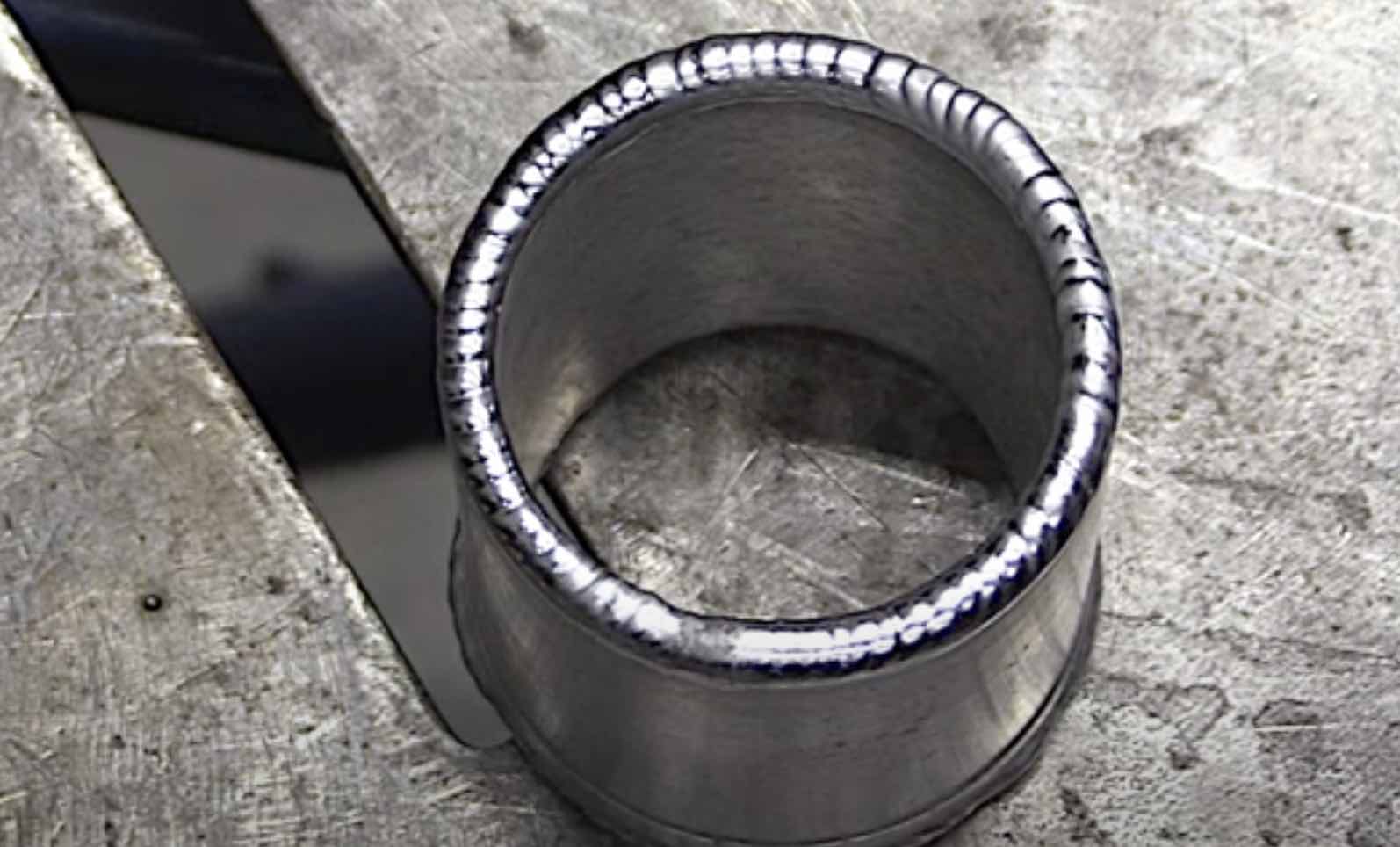
• A/C frequency—electricity from your power company is roughly 60hz in the USA and 50 hz in some other countries.
So the AC frequency on conventional transformer tig welding machines is typically fixed at 60hz in the USA.
An inverter tig welder steps the frequency of the incoming AC power up before it even converts it to DC.
That’s why the transformer is so small and light compared to an old transformer style tig welder…
the A/C frequency setting allows you to adjust the frequency of the AC arc. and lets you weld with a much higher frequency.(HZ) than you can with an older transformer tig welder.
A higher HZ frequency setting stiffens and focuses the tig welding arc..pinpoints the heat more..and sometimes that’s a very good thing…like when you need to put one drop of filler metal on a pit in an aluminum injection mold. or when you need to weld near threads and you don’t want to arc off and damage the threads.
rule of thumb here is lower frequency for thicker aluminum and higher frequency settings for thinner aluminum...but there are always exceptions.

• A/C balance—Alternating current contains both electrode positive and electrode negative changing rapidly back and forth.
With Old school machines, you get what you get and the ac current is roughly 55 /45 dcep/dcen. or maybe slightly better on newer transformer square wave machines with AC balance settings.
The unbalance is due to something called rectification (ouch that sounds painful)…and you don’t always need all that cleaning action that you get from the dcep side.
But with most modern tig inverters, you can adjust the ac balance to more than 90 % dcen.
Rule of thumb: for nasty aluminum like a boat prop that has some corrosion, adjust the ac balance to where you use more dcep .
For brand new clean aluminum diamond plate, set the ac balance to where you have around 67-75 percent dcen.
But some brands of tig welders have their AC balance knob where the higher number setting indicaties more cleaning so if you set the AC balance knob high and your tip of your electrode melts, try a much lower setting.
• 2t ---for using a switch on the torch handle…when you plug in the foot pedal or torch amperage control, most tig inverters are designed to bypass the 2t and 4t settings because the amperage control overrides all the upslope and downslope stuff.
The 2t setting pretty much turns the torch switch into a 2 position switch. Press the switch , you get and arc. Let off the switch, arc goes out.
uplsope and downslope can be set to taper up and down using 2t or 4t function...but certain machines only enable upslope and downslope in 4t mode.
• 4t—the 4t position is most always used in conjunction with upslope and downslope settings…something like this…
1.press the button and you get an arc.
2 Let off the button and the arc upslopes to whatever the main aperage is set to
Weld
3 Press the button and arc downslopes to lower amperage
4 Let off the button and arc quits.
Some machines are different but this is the general principle of 4t operation
This video will explain 2t and 4t settings using a very affordable but capable welder
• Tig high freq vs lift arc vs scratch start---tig high frequency lets you start the arc without touching off…the lift arc function lets you weld without high frequency if that’s important to you like if you are welding in an air traffic control tower….
scratch start is basically the stick setting. If you are used to a plain jane dry rig, you might use scratch start.Some machines have a lift arc mode for situations where high frequency current might interfere with nearby electronics or communications equipment
• Pre-flow—the length of time the torch gas flows between the time you press the switch or remote foot pedal, and when you actually get an arc. No need to have more than 0.5 or 1 second...one exception is when you need a perfectly clean start on aluminum...sometimes a full 2 second start makes a difference on arc starts
• Post-flow-- the length of time the torch gas flows after the arc terminates.
• Up slope—allows the current to climb at whatever rate you set…from start amperage to operating main amperage setting on the machine
• Down slope—allows the current to decrease at whatever rate you set on the knob so that you wont leave a defect like a fish eye or crater crack
• Start amps —allows for a really low amperage startup or a hot one
• End amps—determines the final amperage before the arc quits
• Pulse frequency---pps or pulses per second…you might think that once you get above 30 pps it would be like no pulse at all…you would be wrong. Higher pulse rates really focus the arc.
• Pulse percentage of background current or peak pulse percentage—lets you control the effect of pulse to limit heat input or just to agitate the puddle.
• Pulse % on time also called pulse width—the time the high pulse amperage stays on
Dang! Anything else!!??

